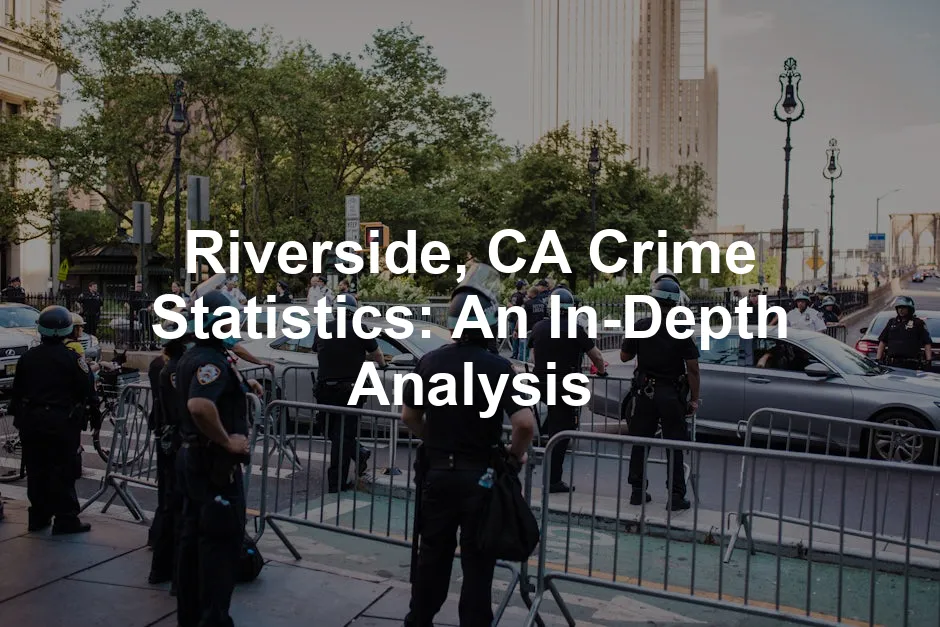Introduction
Riverside, California, is a vibrant city located in the heart of the Inland Empire. With a diverse population of over 327,000 residents, Riverside is celebrated for its rich history and cultural landmarks. The city is home to the historic Mission Inn, stunning botanical gardens, and a plethora of parks. As the 12th largest city in California, Riverside plays a significant role in the state’s economy and community landscape.
Understanding crime statistics is vital for residents, prospective movers, and city planners. For residents, these statistics can help gauge personal safety and community well-being. Potential movers benefit from this information by making informed decisions about where to settle down. City planners utilize crime data to develop strategies for crime prevention, resource allocation, and community enhancement.
This article aims to provide a comprehensive overview of crime statistics in Riverside, CA. We will compare Riverside’s crime rates with national and state averages, helping readers better understand the local crime landscape. By examining the statistics, residents can better navigate the city’s safety and engage in meaningful discussions about community improvement.

Understanding Riverside’s Crime Landscape
Overview of Crime Rates
Riverside has an overall crime rate of 39 per 1,000 residents. This number highlights the challenges faced by the city, as it stands higher than 92% of communities nationwide. In comparison, the national average for overall crime is approximately 26 per 1,000 residents. This stark contrast can raise eyebrows and questions about the safety of living in Riverside.
When we break down the statistics, Riverside’s violent crime rate hovers around 5.19 per 1,000 residents. This rate is notably above the national median of 4 per 1,000. Similarly, property crime rates in Riverside soar at 34.05 per 1,000 residents, significantly exceeding the national average of 20 per 1,000. These statistics paint a concerning picture of the city’s crime landscape.

For those looking for peace of mind, consider investing in a Home Security System. With increasing crime rates, having a reliable system can deter potential threats and give you a sense of security in your own home.
Types of Crimes
Violent Crimes
Violent crimes include serious offenses such as murder, assault, robbery, and rape. In Riverside, violent crime rates are a pressing concern. The statistics reveal that Riverside experienced 1,664 violent crimes last year, translating to a rate of 5.19 per 1,000 residents. This is higher than the state average of 4.99 per 1,000 and the national average of 4 per 1,000. Each of these categories has its own implications for community safety.

Property Crimes
Property crimes comprise offenses like burglary, theft, and motor vehicle theft. Riverside’s property crime rate is particularly alarming, with a total of 10,921 reported incidents. This equates to approximately 34.05 per 1,000 residents, again surpassing both state and national averages. The high rates of property crimes, especially theft and vehicle theft, highlight a crucial area of focus for local law enforcement and community initiatives.
By understanding these crime rates and types, residents can better grasp the safety dynamics of Riverside. This knowledge is essential for fostering community engagement and encouraging collaborative efforts to address crime-related issues.
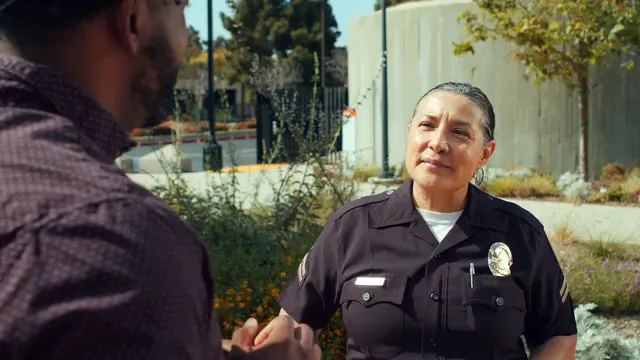
Enhancing personal safety is a must, and a Personal Safety Alarm can be a lifesaver. It’s compact, easy to carry, and can emit a loud sound that helps attract attention in emergency situations. Better to have it and not need it than need it and not have it!
Detailed Crime Statistics
General Crime Data
Riverside, CA, has faced significant challenges concerning crime rates in recent years. The total number of crimes reported in the city stands at a staggering 12,585. Among these, violent crimes account for 1,664 incidents, while property crimes account for a whopping 10,921. When we break these numbers down, we find Riverside has a crime rate of 39 per 1,000 residents. This showcases a clear picture of the safety dynamics in the city.
To visualize the trends, we can look at crime rate changes from 2018 to 2022. Interactive charts reveal that violent crime rates have fluctuated slightly over the years, with a noticeable increase in specific categories. For instance, the murder rate has remained relatively stable, while robbery and assault rates have shown an upward trend. Property crimes, particularly theft, have consistently dominated the statistics, raising concerns among residents about their safety.

Violent Crimes Breakdown
Murder: In Riverside, the murder rate is 0.06 per 1,000 residents, with 18 reported murders last year. While this number seems low, it still represents a tragic loss of life and concerns about community safety.
Rape: The statistics show 141 reported rapes, translating to a rate of 0.44 per 1,000 residents. This figure highlights ongoing concerns regarding personal safety and the need for community vigilance.
Robbery: The robbery rate sits at 1.36 per 1,000 residents, with 435 incidents reported. This rate indicates a growing concern for property safety, as it often leads to heightened anxiety among residents.
Assault: Assaults are particularly prevalent in Riverside, with 1,070 incidents reported, resulting in a rate of 3.34 per 1,000 residents. This alarming statistic emphasizes the importance of community awareness and law enforcement efforts.

Property Crimes Breakdown
Burglary: Burglary statistics reveal that there were 1,633 incidents, translating to a burglary rate of 5.09 per 1,000 residents. This number has raised eyebrows, particularly in neighborhoods that may feel the brunt of these invasions.
Theft: The theft rate is a staggering 23.30 per 1,000 residents, with 7,473 reported thefts. This high number raises questions about the effectiveness of local security measures and the need for community engagement in crime prevention.
Motor Vehicle Theft: Motor vehicle theft poses a significant issue in Riverside, with a rate of 5.66 per 1,000 residents, amounting to 1,815 incidents. This statistic places Riverside among cities with high vehicle theft rates, prompting residents to take extra precautions to protect their property.

Consider installing Security Camera System to monitor your property. It’s a proactive way to deter theft and ensure you have evidence in case of an incident. Plus, they can provide you with peace of mind when you’re not home.
Crime Comparison with National and State Averages
When we compare Riverside’s crime rates to national medians, the differences are striking. The national median for violent crime sits at 4 per 1,000, while Riverside’s rate is a concerning 5.19 per 1,000. In terms of property crimes, Riverside’s rate of 34.05 per 1,000 far exceeds the national average of 20 per 1,000.
In California, the median for violent crime is 4.99 per 1,000, which means Riverside is still above state averages, indicating a need for community engagement and law enforcement initiatives. Additionally, Riverside’s property crime rate surpasses the California median of 23.43 per 1,000, further underscoring the challenges faced by the community.
Overall, these detailed statistics paint a clear picture of Riverside’s crime landscape. They highlight the importance of community awareness, law enforcement involvement, and neighborhood engagement to foster a safer environment for all residents. By understanding these crime trends, residents can take proactive steps to protect themselves and their property, contributing to a more secure Riverside.

Community Perception of Crime
Local Sentiment
Riverside residents have a unique perspective on crime. According to a recent survey, 34% of locals feel safe walking alone at night. However, a significant 66% express concerns about safety. This discrepancy between feelings of safety and actual crime statistics is intriguing. Despite Riverside’s crime rate of 39 per 1,000 residents, many believe their neighborhoods are safer than reported.
The fear of crime often overshadows the reality. The statistics indicate that while crime exists, the perception may be exaggerated. For instance, the chance of becoming a victim of violent crime is approximately 1 in 193, while property crime stands at 1 in 29. This means many residents live in fear, even if they are statistically less likely to encounter crime.
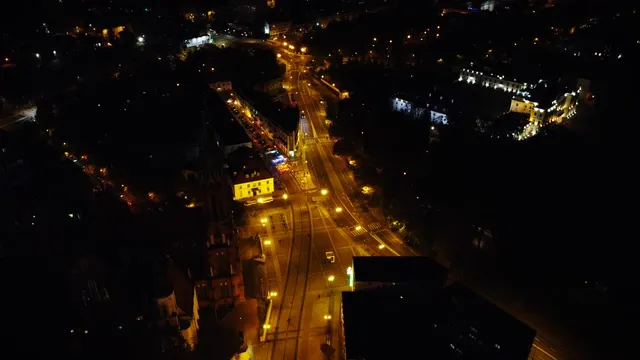
Community discussions often highlight the need for improved law enforcement visibility. Many residents desire a stronger police presence to bolster their sense of security. It’s essential to bridge the gap between perception and reality. By fostering open dialogue, residents can gain a clearer understanding of safety in Riverside, leading to a more informed community.
Neighborhood Comparisons
Riverside boasts diverse neighborhoods, each with varying crime rates. Downtown experiences higher crime levels, while neighborhoods like Canyon Crest enjoy lower rates. This disparity reflects socioeconomic factors influencing crime.
Downtown, with its bustling atmosphere, attracts both residents and visitors, which can lead to increased crime. Property crime is particularly prevalent in this area, where opportunities for theft and burglary are higher. Conversely, Canyon Crest, known for its family-friendly environment and higher-income residents, tends to experience fewer incidents.
Socioeconomic status plays a crucial role in crime rates. Areas with limited job opportunities often see higher crime levels. Conversely, neighborhoods with better economic prospects, like Canyon Crest, typically enjoy lower rates. This correlation emphasizes the importance of addressing economic disparities to enhance community safety.

Improving job opportunities and community resources can lead to decreased crime in struggling neighborhoods. By investing in education and employment initiatives, Riverside can foster an environment that promotes safety and reduces crime rates. Engaging residents in these discussions can empower them to take an active role in improving their communities.
Factors Influencing Crime Rates
Economic Factors
Economic conditions significantly influence crime rates in Riverside. Unemployment rates directly correlate with crime levels. When people struggle to find work, desperation can lead to criminal activity. In Riverside, the current unemployment rate hovers around 4.1%, slightly below the national average of 4.7%. However, this figure doesn’t tell the whole story.
Areas with limited job opportunities often see an upsurge in crime. When individuals cannot secure stable employment, they may resort to illegal activities to support themselves. Conversely, neighborhoods with robust job markets tend to experience reduced crime rates. This relationship highlights the need for economic development initiatives in Riverside.

Job opportunities can serve as a deterrent to crime. By increasing access to employment, the city can help residents build better lives. Programs that focus on job training and skill development are essential. These initiatives can empower individuals, leading to more significant community stability and reduced crime.
Moreover, community engagement is vital. Residents can participate in local programs and advocate for better job opportunities. By working together, the community can address economic disparities and foster a safer environment for all. Investing in the local economy is not just about numbers; it’s about creating a thriving community where everyone has the chance to succeed.
In summary, understanding the economic factors behind crime is crucial for Riverside. By connecting job opportunities to crime rates, the city can craft more effective strategies for reducing crime and enhancing community safety.
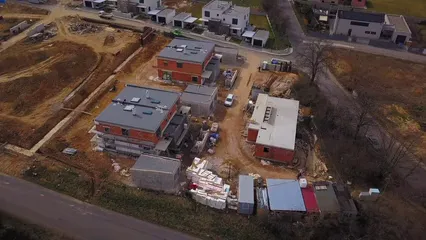
Law Enforcement and Community Efforts
Riverside has a proactive police department committed to community safety. The Riverside Police Department employs community policing initiatives. These programs encourage collaboration between residents and officers. They aim to build trust and improve public safety perceptions.
One notable initiative is the “Riverside Neighborhood Watch Program.” It empowers residents to look out for one another. Participants receive training on crime prevention strategies. This approach fosters a sense of community and vigilance.
Moreover, the department utilizes technology effectively. With crime mapping tools, residents can track local incidents. This transparency helps citizens stay informed and engaged.
Community programs also focus on youth engagement. The “Police Athletic League” offers recreational activities for kids. By providing positive outlets, this program reduces youth crime rates.

These efforts show a commitment to both prevention and collaboration. An engaged community can significantly contribute to crime reduction.
Social and Environmental Factors
Housing conditions play a pivotal role in Riverside’s crime dynamics. Well-maintained neighborhoods typically see lower crime rates. Conversely, areas with neglected properties often attract criminal activity.
Research shows that communities with strong neighborhood upkeep report fewer incidents. A clean, orderly environment fosters pride and vigilance among residents. This can deter potential criminal behavior, as people feel invested in their community.
Community engagement is equally vital in crime prevention. When residents actively participate in local initiatives, they create a watchful atmosphere. Programs that promote neighborly connections can enhance safety.
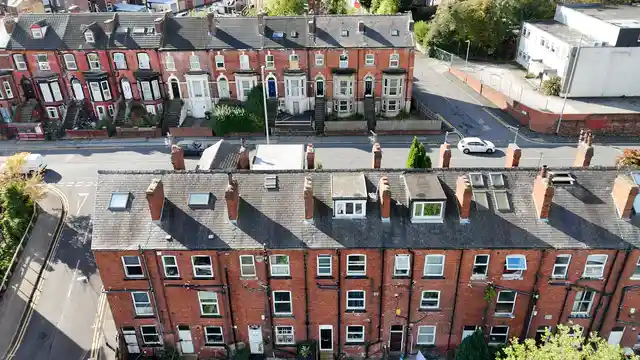
Regular community gatherings establish trust and cooperation. Such interactions increase communication about safety concerns. This proactive approach can lead to quicker responses to suspicious activities.
In summary, maintaining housing quality and promoting community engagement are essential. These factors contribute to a safer Riverside for everyone.
Conclusion
Riverside faces significant challenges regarding crime rates. The overall crime rate stands at 39 per 1,000 residents, which is alarming. Residents perceive crime differently than the statistics suggest. While many feel unsafe, the actual chances of becoming a victim are lower than perceived.
Key findings indicate that violent crimes such as assault and robbery are prevalent. Property crimes, particularly vehicle theft, also demand attention. The police department’s community-oriented approach has proven effective. Programs geared toward engagement and prevention show promise.
Looking ahead, Riverside may see changes in crime trends. With ongoing community efforts and police initiatives, there is hope for improvement. Continued investment in neighborhood programs can foster a safer environment.
Residents are encouraged to stay engaged and informed. Participating in local initiatives, such as neighborhood watch programs, can make a difference. When communities unite, they create safer spaces for everyone.
Riverside’s future depends on the collective efforts of its residents and law enforcement. Together, they can combat crime and enhance the quality of life in the city. For a deeper understanding of crime statistics, check out this comprehensive analysis of Texas crime rate statistics.
Understanding crime statistics is essential for grasping the safety dynamics in any city, including Riverside. For more detailed insights, refer to the texas crime rate statistics.
FAQs
What is the overall crime rate in Riverside, CA?
Riverside, CA, has an overall crime rate of 39 per 1,000 residents. This alarming statistic places Riverside among the cities with the highest crime rates in the United States. The chance of becoming a victim of either violent or property crime is about 1 in 25, which raises eyebrows and concerns for residents and potential movers alike.
How does Riverside compare to other California cities regarding crime?
Riverside’s crime rate is notably higher than many other cities in California. For instance, while Riverside’s property crime rate is approximately 34.05 per 1,000 residents, cities like Eastvale and Norco boast much lower crime rates. In fact, Riverside ranks higher than 92% of communities nationwide, making it a hot topic for those considering relocation.
What neighborhoods in Riverside are considered safe?
Some neighborhoods in Riverside are perceived as safer than others. Areas like Canyon Crest, Orangecrest, and Hawarden Hills often report lower crime rates. These neighborhoods typically feature better lighting, community engagement, and active neighborhood watch programs, contributing to their reputation as safe havens.
How can residents contribute to reducing crime in their community?
Residents play a vital role in enhancing community safety. By participating in local initiatives, such as neighborhood watch programs, they can become the eyes and ears of their communities. Encouraging open communication with law enforcement, attending community meetings, and reporting suspicious activities can significantly reduce crime. Every little effort adds up!
Where can I find more detailed crime statistics for Riverside?
For those digging deeper into crime statistics, the Riverside Police Department offers various resources. Their website features a Crime Mapping Dashboard, along with downloadable crime data and reports. You can also visit NeighborhoodScout for comprehensive crime analytics. Engaging with these resources helps residents stay informed about their community’s safety dynamics.
For those who love to explore the outdoors, a reliable Outdoor Adventure Gear could be just what you need! Whether you’re hiking, camping, or just enjoying a day at the park, having the right gear can make your experience much more enjoyable and safe.
Please let us know what you think about our content by leaving a comment down below!
Thank you for reading till here 🙂
All images from Pexels

